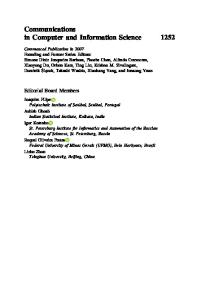Distributed Generative Adversarial Networks for Anomaly Detection
Cognitive radio networks can be used to detect anomalous and adversarial communications to achieve situational awareness on the radio frequency spectrum. This paper proposes a distributed anomaly detection scheme based on adversarially-trained data models
- PDF / 33,042,215 Bytes
- 518 Pages / 439.37 x 666.142 pts Page_size
- 94 Downloads / 338 Views
Quanyan Zhu John S. Baras Radha Poovendran Juntao Chen (Eds.)
Decision and Game Theory for Security 11th International Conference, GameSec 2020 College Park, MD, USA, October 28–30, 2020 Proceedings
Lecture Notes in Computer Science Founding Editors Gerhard Goos Karlsruhe Institute of Technology, Karlsruhe, Germany Juris Hartmanis Cornell University, Ithaca, NY, USA
Editorial Board Members Elisa Bertino Purdue University, West Lafayette, IN, USA Wen Gao Peking University, Beijing, China Bernhard Steffen TU Dortmund University, Dortmund, Germany Gerhard Woeginger RWTH Aachen, Aachen, Germany Moti Yung Columbia University, New York, NY, USA
12513
More information about this subseries at http://www.springer.com/series/7410
Quanyan Zhu John S. Baras Radha Poovendran Juntao Chen (Eds.) •
•
•
Decision and Game Theory for Security 11th International Conference, GameSec 2020 College Park, MD, USA, October 28–30, 2020 Proceedings
123
Editors Quanyan Zhu Tandon School of Engineering New York University Brooklyn, NY, USA Radha Poovendran Electrical Engineering University of Washington Seattle, WA, USA
John S. Baras ISR University of Maryland College Park, MD, USA Juntao Chen New York University New York, NY, USA
ISSN 0302-9743 ISSN 1611-3349 (electronic) Lecture Notes in Computer Science ISBN 978-3-030-64792-6 ISBN 978-3-030-64793-3 (eBook) https://doi.org/10.1007/978-3-030-64793-3 LNCS Sublibrary: SL4 – Security and Cryptology © Springer Nature Switzerland AG 2020 This work is subject to copyright. All rights are reserved by the Publisher, whether the whole or part of the material is concerned, specifically the rights of translation, reprinting, reuse of illustrations, recitation, broadcasting, reproduction on microfilms or in any other physical way, and transmission or information storage and retrieval, electronic adaptation, computer software, or by similar or dissimilar methodology now known or hereafter developed. The use of general descriptive names, registered names, trademarks, service marks, etc. in this publication does not imply, even in the absence of a specific statement, that such names are exempt from the relevant protective laws and regulations and therefore free for general use. The publisher, the authors and the editors are safe to assume that the advice and information in this book are believed to be true and accurate at the date of publication. Neither the publisher nor the authors or the editors give a warranty, expressed or implied, with respect to the material contained herein or for any errors or omissions that may have been made. The publisher remains neutral with regard to jurisdictional claims in published maps and institutional affiliations. This Springer imprint is published by the registered company Springer Nature Switzerland AG The registered company address is: Gewerbestrasse 11, 6330 Cham, Switzerland
Preface
Cybersecurity is a major challenge of today’s connected world as we are becoming increasingly connected by the recent advances in information and communication technologi











